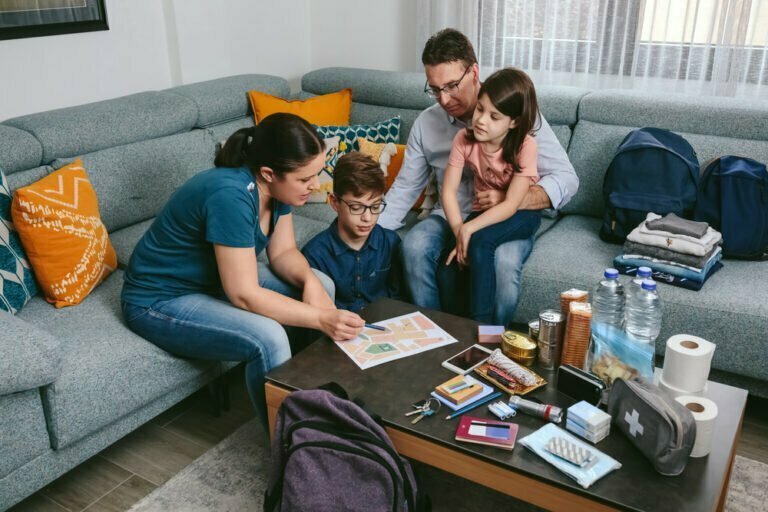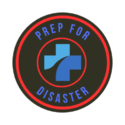In an ever-changing and unpredictable world, families need to have a well-thought-out emergency plan in place. The significance of having family emergency plans cannot be overstated, as they can mean the difference between chaos and calm when faced with unexpected emergencies. While we may hope that emergencies never occur, being prepared allows us to tackle any situation with confidence, ensuring the safety and well-being of our loved ones.

Safeguarding Lives and Minimizing Damage
The primary purpose of creating family emergency plans is to safeguard lives and minimize damage during times of crisis. Emergencies can come in various forms – natural disasters like hurricanes, earthquakes, floods, or artificial incidents such as house fires or power outages.
Regardless of the type of emergency you might face, having a solid plan empowers your family to respond swiftly and effectively. A well-prepared family emergency plan accounts for potential risks specific to your region while addressing the unique needs of each family member.
It establishes clear communication strategies, evacuation routes, designated meeting points inside and outside your home or neighborhood, and procedures for accessing essential supplies. This comprehensive approach ensures that everyone knows what to do in critical moments when time is of the essence.
An Empowering Approach
Beyond just practical considerations, having a family emergency plan instills a sense of empowerment within each member. Families foster resilience and cohesion even in the face of adversity by proactively discussing potential emergencies and preparing for them together as a unit. This collective effort strengthens bonds and boosts confidence in one’s ability to handle challenging situations.
Moreover, creating family emergency plans allows open conversations about safety measures at home or within the community. It is an educational tool that teaches children and adults about emergency preparedness, basic life-saving skills, and staying informed.
Families become better equipped to face immediate threats and future emergencies through this process. In the following sections, we will delve deeper into the components of a comprehensive family emergency plan.
By understanding what it entails and why it matters so much, you can construct tailored family emergency plans that suit the unique needs of your own family. Remember: being prepared is not just a practical necessity but an act of love and protection for those closest to you.
Understanding Potential Emergencies

Natural disasters are unpredictable events that can cause significant damage and threaten human lives. Understanding the different types of natural disasters and their potential impact is crucial for developing an effective family emergency plan.
Hurricanes are powerful tropical storms characterized by strong winds and heavy rainfall. These storms can lead to widespread flooding, destruction of homes, and power outages.
It is important to know your region’s vulnerability to hurricanes and have evacuation routes planned accordingly. Earthquakes occur when tectonic plates beneath the Earth’s surface shift suddenly.
The resulting tremors can cause buildings to collapse, landslides, and tsunamis in coastal areas. Knowing the appropriate response during an earthquake (such as “Drop, Cover, Hold On”) is essential for protecting yourself and your family.
Floods are common natural disasters that result from excessive rainfall or dam failures. They can lead to property damage, displacement of families from their homes, contaminated water sources, and disease outbreaks.
Familiarize yourself with flood-prone areas in your region and develop evacuation plans accordingly. Wildfires are fast-spreading fires that consume everything in their path. Dry conditions and strong winds often fuel them. Understanding the risks associated with wildfires in your area is crucial for planning evacuation routes and determining safe meeting points.
Artificial emergencies (house fires, power outages, chemical spills)
While natural disasters grab headlines due to their magnitude, artificial emergencies can occur more frequently in our daily lives. It is imperative to be prepared for these situations as well.
House fires pose a significant threat to families worldwide. They can spread rapidly through homes due to electrical faults or negligence with flammable substances such as cooking oil or candles.
Knowing how to prevent fires through proper safety measures, having fire extinguishers readily available, and establishing escape routes are vital aspects of a family emergency plan. Power outages can occur due to severe weather conditions or issues with the electrical grid.
In such situations, families should be prepared with alternative sources of lighting, non-perishable food items, and a communication plan to stay connected with each other and the authorities. Chemical spills can happen in industrial areas or during transportation accidents.
These spills may release hazardous substances into the environment, posing risks to human health. Understanding the potential dangers associated with chemical spills and knowing how to respond (such as sheltering in place or evacuating) is crucial for ensuring your family’s safety.
Comprehending the potential impact of natural disasters like hurricanes, earthquakes, floods, wildfires, and artificial emergencies such as house fires, power outages, and chemical spills is essential when developing your comprehensive family emergency plans. By understanding these risks and their consequences specific to your region, you can take proactive steps to protect yourself and your loved ones in crisis.
Creating Your Family Emergency Plans
Effective communication can be a lifeline for your family during times of crisis. Establishing a communication tree within the family is vital. This involves assigning specific individuals as key contacts for each family member.
For example, parents can designate one child to contact them while another child contacts other relatives or close friends. This ensures that everyone knows whom to contact and reduces the chances of confusion or panic.
In addition to traditional methods like phone calls, it’s crucial to identify alternative communication methods such as text messages and social media platforms. During emergencies, phone networks may become overloaded or disrupted, making it difficult to make direct calls.
Text messages, on the other hand, often have a higher chance of getting through even in such situations due to their lower bandwidth requirements. Social media platforms like Facebook and Twitter can also be used to communicate by posting updates or sending direct messages.
Evacuation plans for different scenarios in your family emergency plans
Having well-defined evacuation plans for various scenarios is essential for ensuring the safety of your family members. Designating meeting points outside the home and in the neighborhood is crucial so everyone knows where to gather in case you need to leave your residence quickly. It could be a nearby park or a trusted neighbor’s house.
Identifying evacuation routes and potential shelter locations requires thorough research and consideration based on your geographical location and potential risks in your area. Be aware of access points available during emergencies, such as fire exits or designated emergency exits in buildings.
Ensure that every family member understands these routes and has practiced them regularly. Consideration for individuals with disabilities or special needs should play a significant role when creating evacuation plans.
Please consider any physical limitations and plan accordingly by choosing accessible shelters or alternative routes suitable for their requirements. Preparing an emergency kit with essential supplies should also be part of your evacuation plan.
Include non-perishable food, sufficient water for each family member, necessary medications, and a first aid kit to meet everyone’s needs for at least 72 hours. Ensure the supplies are regularly checked and replaced to maintain their freshness and effectiveness.
Remember, the key to successful family emergency plans is thorough preparation and ensuring that every family member understands their role in implementing them effectively. Note: This content is for informational purposes only and should not replace professional advice or guidance in emergencies.
Specific Considerations for Different Family Members
When developing a family emergency plan, it is crucial to consider the unique needs of children and elderly relatives. Explaining family emergency plans to children in an age-appropriate manner is essential for their understanding and cooperation during critical situations.
It is important to balance sharing necessary information and ensuring they do not become overwhelmed or frightened. Teaching them how to dial emergency services: One of the most vital skills you can teach your child is dialing emergency services such as 911.
Explain the purpose of these numbers and how they should only be used in true emergencies. Practice scenarios where they must make a simulated call, ensuring they know their address and phone number.
Assigning them simple tasks during evacuations: Assigning children simple tasks can help them feel involved and less anxious. For example, you can ask them to carry important documents or comfort items like a favorite stuffed animal or blanket.
This keeps them occupied and ensures their cherished belongings are close at hand during stressful times. Memorizing important phone numbers: In case of separation during an emergency, children must know important phone numbers by heart.
Teach them the contact details of immediate family members, close relatives, trusted neighbors, or friends who could assist in reuniting the family. Encourage regular practice of memorizing these numbers so that they can recall them even under stressful circumstances.
Discussing Specific Needs and Concerns of Elderly Relatives
Elderly relatives may have specific needs that require additional consideration when creating a family emergency plan. It is essential to have open conversations about their concerns and requirements beforehand so that appropriate measures can be taken when emergencies arise.
Discuss with elderly relatives any special medical needs they have, such as medications, medical equipment, or mobility aids. Ensure that their emergency kit includes an ample supply of necessary medications and devices they rely on for daily living.
If they have difficulty moving independently, arrange additional assistance or transportation during an evacuation. Consider any specific health conditions or dietary considerations when preparing emergency supplies.
If a power outage occurs, ensure that alternative arrangements are made to meet their nutritional needs, especially if they require refrigerated medications or special diets. Consider discussing evacuation routes and potential shelter locations with elderly relatives in advance.
Some shelters may have specific accommodations for seniors or individuals with disabilities. It is important to familiarize them with the available options to feel more secure and prepared during an emergency.
Remember, open communication and continuous reassurance are key when discussing the specific needs and concerns of elderly relatives in your family emergency plan. By addressing these factors proactively, you can ensure their safety and well-being during critical situations.
Practicing Your Family Emergency Plans
Conducting Regular Drills
Practicing your family emergency plan ensures its effectiveness during a real crisis. By conducting regular drills, you create an opportunity for everyone in the family to familiarize themselves with their roles and responsibilities and the necessary steps to take in different emergency scenarios. These drills help build muscle memory, enabling individuals to react swiftly and calmly in a real-life emergency.
Begin by setting aside dedicated time intervals every few months for conducting these drills. Start with simple scenarios, such as practicing evacuations from different parts of the house or testing communication methods.
Gradually increase the complexity of the exercises as your family becomes more comfortable and confident in their abilities. During these drills, emphasize clear communication and coordination among family members.
Assign specific tasks to each person, such as gathering essential supplies, retrieving important documents, or aiding others with mobility limitations. Encourage everyone to ask questions and provide feedback on how to improve the plan’s effectiveness.

Conclusion – Family Emergency Plans
Having well-prepared family emergency plans is essential for mitigating potential risks and ensuring the safety of your loved ones during unforeseen crises. You are taking proactive measures toward protecting your family by understanding potential emergencies and creating a comprehensive plan that includes communication strategies and evacuation procedures.
However, simply having a plan is not enough; it requires practice to make it truly effective. Regularly conducting drills that simulate different emergency scenarios will empower each family member with crucial knowledge about their roles and responsibilities.
Through practice, you can ensure everyone knows what steps to take without hesitation when facing an emergency. Remember that preparedness breeds confidence — knowing that you have taken concrete steps towards protecting your loved ones will provide peace of mind.
So, invest the time and effort in practicing your family emergency plan, and rest assured that you are well-prepared to face any challenge that may come your way. Stay safe, secure, and united as a family.




